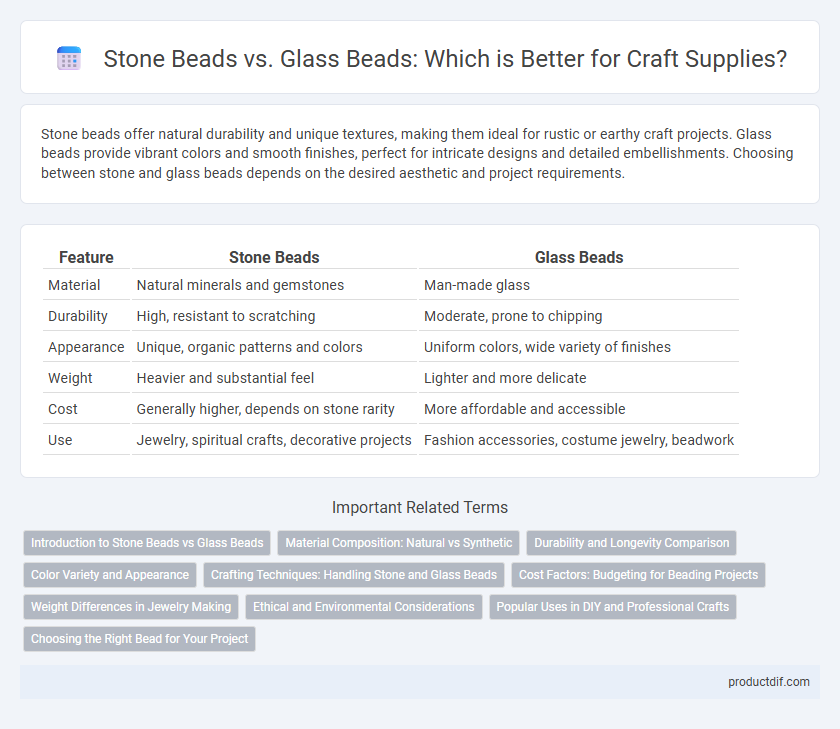Stone beads offer natural durability and unique textures, making them ideal for rustic or earthy craft projects. Glass beads provide vibrant colors and smooth finishes, perfect for intricate designs and detailed embellishments. Choosing between stone and glass beads depends on the desired aesthetic and project requirements.
Table of Comparison
| Feature | Stone Beads | Glass Beads |
|---|---|---|
| Material | Natural minerals and gemstones | Man-made glass |
| Durability | High, resistant to scratching | Moderate, prone to chipping |
| Appearance | Unique, organic patterns and colors | Uniform colors, wide variety of finishes |
| Weight | Heavier and substantial feel | Lighter and more delicate |
| Cost | Generally higher, depends on stone rarity | More affordable and accessible |
| Use | Jewelry, spiritual crafts, decorative projects | Fashion accessories, costume jewelry, beadwork |
Introduction to Stone Beads vs Glass Beads
Stone beads offer natural, unique patterns and durability, making them prized in artisan jewelry and craft projects. Glass beads provide vibrant color varieties, uniform shapes, and affordability, ideal for mass production and detailed designs. Understanding the material properties and aesthetic differences helps crafters choose the right bead type for their specific needs.
Material Composition: Natural vs Synthetic
Stone beads are crafted from natural minerals such as jasper, agate, and turquoise, offering unique patterns and organic texture due to their geological formation. Glass beads, on the other hand, are synthetically produced using silica mixed with soda ash and other additives, allowing for uniform shape, color variety, and enhanced translucency. The natural composition of stone beads appeals to artisans seeking authenticity and durability, while glass beads provide versatile design options with consistent quality.
Durability and Longevity Comparison
Stone beads exhibit superior durability and longevity compared to glass beads due to their natural mineral composition, which resists chipping and cracking under pressure. Glass beads, though aesthetically versatile, are more prone to breakage and surface wear over time, especially with frequent handling or exposure to moisture. For craft projects requiring enduring materials, stone beads provide a reliable choice that maintains appearance and structural integrity over extended periods.
Color Variety and Appearance
Stone beads offer a natural, earthy color palette with unique variations and patterns that highlight their organic origin. Glass beads provide a broader range of vibrant colors and finishes, including opaque, translucent, and iridescent options, allowing for more creative flexibility. The polished, uniform surface of glass beads contrasts with the textured, matte, or polished finish of stone beads, making each ideal for distinct crafting aesthetics.
Crafting Techniques: Handling Stone and Glass Beads
Stone beads require careful handling due to their natural weight and slightly porous surface, making techniques like drilling and stringing more delicate to avoid chipping or cracking. Glass beads, being lighter and smoother, allow for easier manipulation in bead weaving and wire wrapping but demand secure fastening to prevent slipping due to their polished finish. Crafting with stone beads often involves using stronger cords or wires to support their weight, whereas glass beads enable more intricate designs due to their uniform shapes and sizes.
Cost Factors: Budgeting for Beading Projects
Stone beads generally command higher prices due to their natural origin, unique patterns, and durability, making them a premium choice for upscale beading projects. In contrast, glass beads offer a more affordable alternative with a wide range of colors and shapes, ideal for hobbyists or large-scale projects requiring volume without escalating costs. Budgeting for beading projects should consider the balance between the aesthetic quality of stone beads and the cost-effectiveness of glass beads to optimize both design impact and expenditure.
Weight Differences in Jewelry Making
Stone beads typically have a higher density and weight compared to glass beads, making them feel more substantial in jewelry pieces. The increased weight of stone beads can influence the overall comfort and durability of necklaces and bracelets, often providing a more grounded and premium feel. Glass beads, being lighter, offer greater flexibility for intricate designs but may lack the heft that some designers and wearers prefer for luxurious or statement jewelry.
Ethical and Environmental Considerations
Stone beads, often sourced from natural minerals, tend to have a lower environmental impact due to their durability and minimal processing requirements compared to glass beads, which require energy-intensive manufacturing involving high heat and chemical additives. Ethically, stone beads are frequently mined in regions with more transparent labor practices, though concerns about mining conditions persist, whereas glass bead production can involve hazardous factory environments and less regulated labor. Choosing sustainably sourced stone beads or recycled glass beads can mitigate environmental damage and promote fair trade standards in the craft supply industry.
Popular Uses in DIY and Professional Crafts
Stone beads are favored in jewelry making and home decor projects for their natural textures and durability, often used in bracelets, necklaces, and mosaic art. Glass beads offer vibrant colors and uniform shapes, making them ideal for detailed beadwork, embroidery, and costume design. Both types are essential in DIY and professional crafts, with stone beads bringing organic appeal and glass beads providing versatility and precision.
Choosing the Right Bead for Your Project
Stone beads offer natural variations in color and texture, providing an organic and earthy aesthetic ideal for bohemian or rustic jewelry designs. Glass beads deliver consistent shapes and vibrant colors, perfect for intricate patterns and bright, polished finishes. Selecting the right bead depends on the desired look, durability, and project style, with stone beads favored for natural appeal and glass beads chosen for precision and color variety.
Stone beads vs Glass beads Infographic

 productdif.com
productdif.com